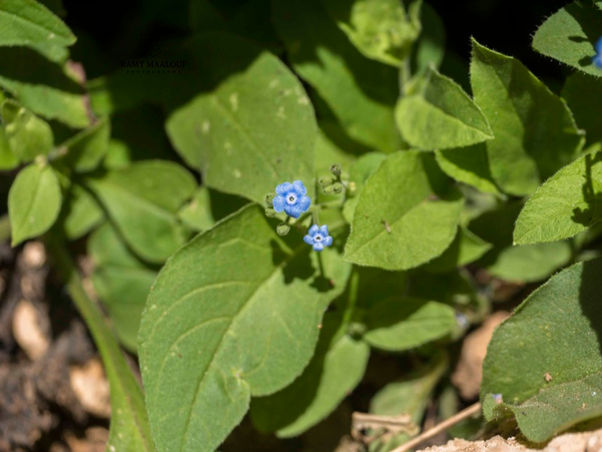Family |
Boraginaceae
Brunnera orientalis
(Schenk) I.M.Johnst.
Brunnera orientalis (Schenk) Johnst.
(Nouvelle Flore du Liban et de la Syrie, vol. 3, Pl. XLI nº 1; 1983)
Life-form & habit: Soft-textured, green perennial, 30–60 cm tall, very branched. Stems flexuous, erect, finely hairy with scattered tuberculate-based bristles, rare pubescence above.
Leaves: Large, slightly sinuate-dentate; basal leaves ovate-oblong, petiolate; middle leaves sessile, tapered at base and acute; upper leaves subamplexicaul and acute.
Inflorescence & flowers: Cymes without bracts, loose and paniculate, nodding at the end. Flowers small, recalling Myosotis.
Calyx: Less than 2 mm long before anthesis, lobed with short, lanceolate segments, becoming enlarged at fruiting.
Corolla: Bright azure blue (rarely white), salver-shaped with a short tube not exceeding the calyx; limb flat, widely lobed, 4–5 mm in diameter, quickly withering.
Fruit: Small, semi-ovoid nutlets with a short oblique beak, finely rugose-areolate.
Phenology: Flowers from March to May.
Habitat & elevation: Montane and inland habitats, often shaded.
Lebanese distribution: Mi. Maasser ech-Chouf, Lahfed; Mm. Jabal Kneissé, Col de Zahlé, Faraya, Ehden, Qannoubine, Hasroun, Dimane, Bka‘ Kafra, Les Cèdres, Sir-ed-Denniyé, Jabal Sannine, Afqa, Jabal Fughri, above Bcharré, N. of Ehden, mountains of ‘Akkar; Me. Col des Cèdres; Ve. Mchaïtiyé to ‘Aïnata, ‘Aïnata; Herm. Rachaya; A.L. Cha‘ra de Baalbek, Ouadi el-Harir.
Native range: Iran, Iraq, Lebanon-Syria, Palestine, Türkey.





